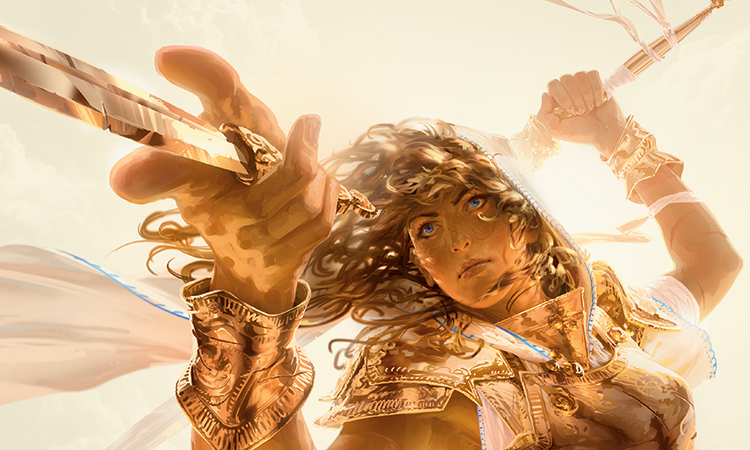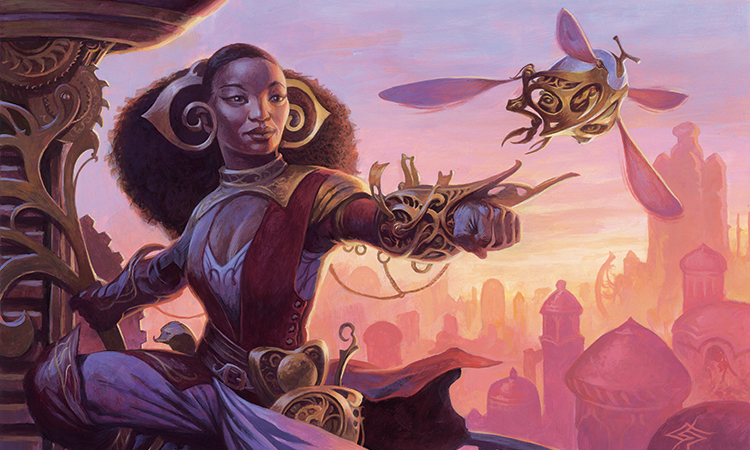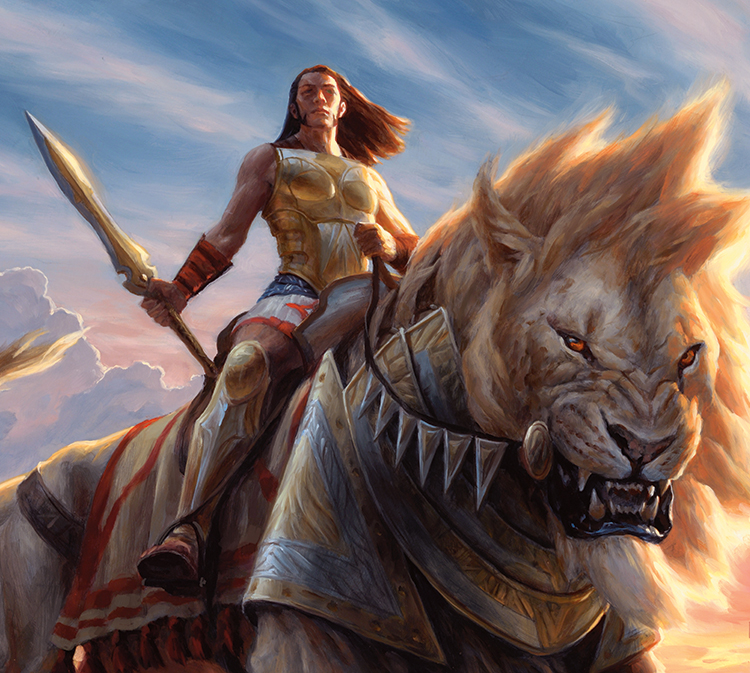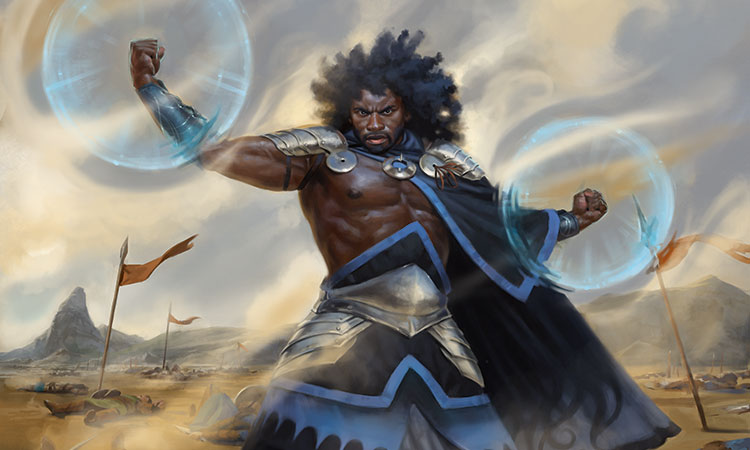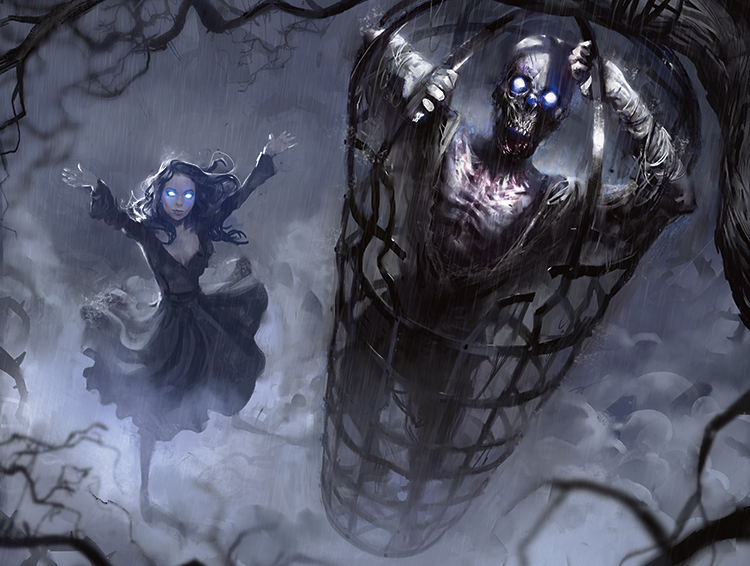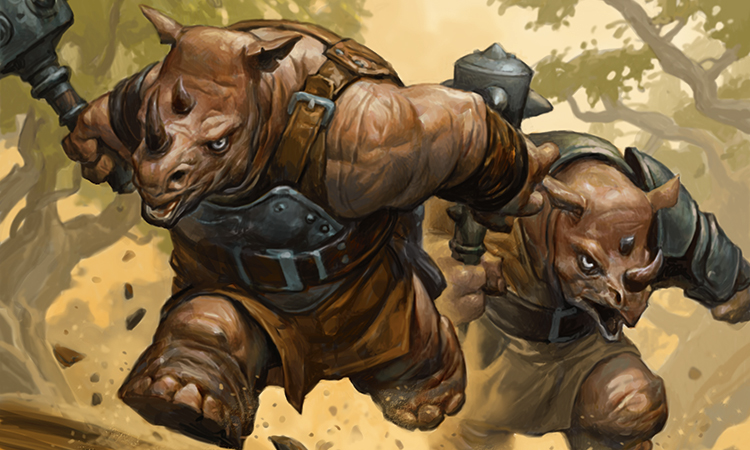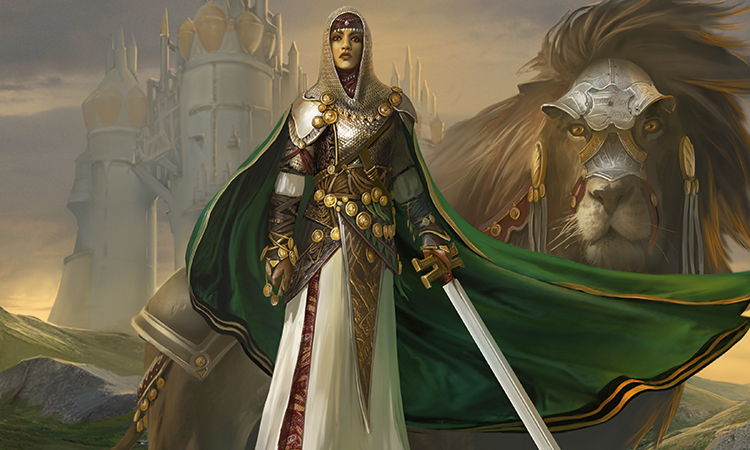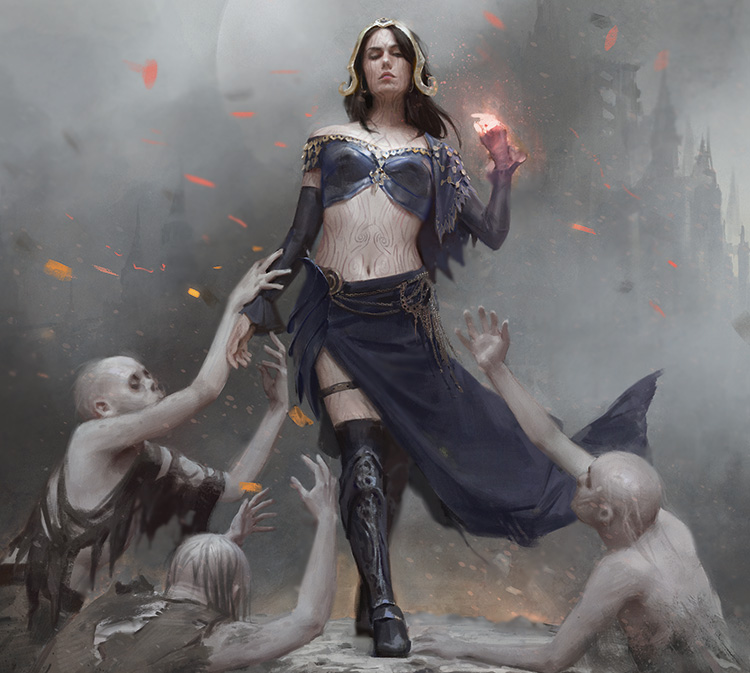Welcome back to Magic Gatherings! We’ll be doing a double feature this week to celebrate the newest set, Magic Origins. In this article, like I did for Dragons of Tarkir, I’ll break down Magic Origins for limited play and take a look at what the draft and sealed environments will be like—just in time for the prerelease this weekend!
As a quick aside: if you’re new to prereleases, or to limited Magic in general, take a look at Gavin Verhey’s prerelease primer on DailyMTG.com. It has a lot of useful tips for the new player. For the record, the most important thing to do at a prerelease is have fun—so if you pick your favorite color and play it, you are doing just fine. This goes double for newer players, like Tim Lanning.
With that said, let’s get down to business. I’ll start with some general observations about the set, then talk about each color in more detail.
For the last-ever Core Set, this does not look like a Core Set
Conventional wisdom says that Core Set limited formats tend to be slower than expert-level expansions. Core Sets have clunkier creatures and fewer keywords, so there are fewer games decided by synergistic decks and more games decided on raw power level—particularly the power level of “bombs,” the best (and usually rarest) cards in your deck.
For example, the common creatures in last year’s Core Set, Magic 2015, were a bunch of hot garbage. There was a mishmash of powers and toughnesses, and very few creatures had relevant abilities. As a result, players didn’t want to attack or block—too much chance that their creatures would trade for other twerpy dudes. This meant that games amounted to a whole lot of nothing until one player resolved [mtg_card]Siege Wurm[/mtg_card] or [mtg_card]Triplicate Spirits[/mtg_card].
By contrast, the common and uncommon creatures in Magic Origins look very similar to those in Dragons of Tarkir—plenty of efficient creatures at low mana costs, with a better range of bigger bodies up the curve. The creatures don’t get quite as big as they do in Dragons (there’s nothing like [mtg_card]Aerie Bowmasters[/mtg_card], which sets the bar for mid-level creatures), but on the whole it should be more like a regular draft environment than a core set environment.
The format will be a little slower than Dragons of Tarkir
Even though you can’t expect the full “Core Set Experience,” Magic Origins limited should still be a bit slower than Dragons limited. There are fewer hard-hitting creatures at the middle-to-high mana costs (especially four and five), so it should be a little bit harder to take over games. That said, the renown mechanic will give creatures a fair bit of staying power, so early aggressive creatures can continue to be relevant into the late game.
The bigger difference is that the removal is of lower quality than in Dragons. DTK didn’t set any records for amazing removal, but it had flexible spells like [mtg_card]Sarkhan’s Rage[/mtg_card] and [mtg_card]Flatten[/mtg_card] alongside efficient, tempo-generating spells like [mtg_card]Epic Confrontation[/mtg_card] and [mtg_card]Pacifism[/mtg_card]. In Magic Origins, much of the removal is sorcery-speed only, and the best unconditional removal costs four or five mana. It will either be less reliable ([mtg_card]Celestial Flare[/mtg_card] vs. [mtg_card]Enduring Victory[/mtg_card]) or more expensive ([mtg_card]Suppression Bonds[/mtg_card] vs. [mtg_card]Pacifism[/mtg_card]).
What remains to be seen is how attractive it will be to attack with creatures in actual games. In addition to making your early creatures a little better in later turns, renown will also encourage you to attack with them early. Once you connect, you can probably keep attacking profitably. It’s also worth noting that renown makes combat tricks better, of which the most relevant are [mtg_card]Enshrouding Mist[/mtg_card], [mtg_card]Mighty Leap[/mtg_card], [mtg_card]Might of the Masses[/mtg_card], and [mtg_card]Titanic Growth[/mtg_card]. That last one, in particular, is a big (Titanic?) deal; +4/+4 makes basically any creature bigger than basically any other creature in the set.
Flying will matter
Over on his personal blog, “Ars Arcanum” author Matthew Watkins found that Dragons of Tarkir was among the sets with the highest density of flying creatures ever. Between commons and uncommons, DTK had 22 flyers, many of which were the titular dragons.
Magic Origins has only 17 flyers at common and uncommon. (For purposes of discussion, I’m counting creatures that make 1/1 Thopter tokens, as well as [mtg_card]Orchard Spirit[/mtg_card].) But whereas Dragons saved most of its flying power for its eponymous death lizards, Origins has 11 common flyers—more than Dragons has at common (8, if you’re wondering).
More to the point, Magic Origins has more flyers you’re likely to want to actually play. Dragons seems to have held back on flying power at common to make its dragons more special; flyers like [mtg_card]Updraft Elemental[/mtg_card] and [mtg_card]Territorial Roc[/mtg_card] never saw much action. Origins is sure to have a few duds—[mtg_card]Faerie Miscreant[/mtg_card], maybe—but it also has cards like [mtg_card]Scrapskin Drake[/mtg_card] and [mtg_card]Charging Griffin[/mtg_card].
I suspect a lot of this is to accommodate the Thopter cards in blue and red. Even so, a higher density of flyers should tend to push games past ground stalls and toward a natural conclusion.
3/3 is pretty big; 4/4 is huge
This will become more apparent as we work our way through the various colors, but taken as a whole, 2/2 looks like the baseline power and toughness in this set. There are some 3/2s which will trade down, and some 2/3s which will block well against creatures of those size. In a world like that, 3/3 is a good creature, and a 4/4 can block most anything.
That said, most colors have some options for defending against or attacking with creatures that big. [mtg_card]Rhox Maulers[/mtg_card] becomes a 6/6. [mtg_card]Prickleboar[/mtg_card] swings through almost every blocker. Blue has [mtg_card]Deep-Sea Terror[/mtg_card], if it wants it. And most colors get a 4/4 for 5 mana at uncommon.
White
Here’s a chart of white’s common and uncommon creatures, for those who love data. (Sorry for the crappy layout.)
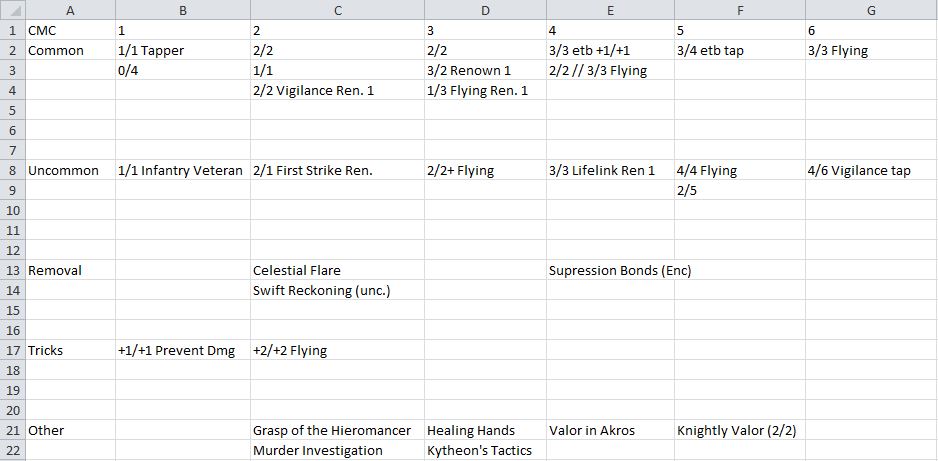 [A quick methodological note: in compiling these charts, I’m chiefly interested in the combat stats for the creatures in each color. Since creatures form the basis of limited formats, and creature combat provides the major texture for limited game’s that’s the most crucial information for envisioning how a set will play out. Common and uncommon creatures show up the most frequently, and therefore matter the most, so I eschew the rares.]
[A quick methodological note: in compiling these charts, I’m chiefly interested in the combat stats for the creatures in each color. Since creatures form the basis of limited formats, and creature combat provides the major texture for limited game’s that’s the most crucial information for envisioning how a set will play out. Common and uncommon creatures show up the most frequently, and therefore matter the most, so I eschew the rares.]
What jumps out at me most immediately is that white has several options for aggressive creatures at two, three, and four mana. [mtg_card]Cleric of the Forward Order[/mtg_card] is perfectly fine as a baseline bear (a 2/2 for two mana), and [mtg_card]Topan Freeblade[/mtg_card] is all that with tons of upside. Similarly, [mtg_card]Knight of the Pilgrim’s Road[/mtg_card] is already playable as a 3/2; the renown is essentially free. [mtg_card]Stalwart Aven[/mtg_card] is not great as a 1/3 flyer for three, but as a 2/4 flyer it is a seriously good deal—good enough to be one of white’s best commons. At four mana, [mtg_card]Ampryn Tactician[/mtg_card] is a 3/3 with a relevant ability, and [mtg_card]Charging Griffin[/mtg_card] attacks as well as the six-mana [mtg_card]Aven Battle Priest[/mtg_card].
In contrast, white seems to be lacking larger creatures, which is often the case. Here, though, there seem to be fewer high-toughness creatures than we might expect. [mtg_card]Heavy Infantry[/mtg_card] can block most cheaper creatures, but doesn’t fight well against creatures in other colors that also cost five mana.
What all this says is that white wants to be pretty aggressive in this set, attacking early and triggering renown. If you can do that, the extra +1/+1 will keep your creatures relevant into the later turns of the game. Renown also combines well with [mtg_card]Mighty Leap[/mtg_card] and [mtg_card]Enshrouding Mist[/mtg_card], since your opponent will be more likely to block your renown creatures if they can.
Slower white decks will probably want to turn to another color for early defense, though if they can get [mtg_card]Topan Freeblade[/mtg_card] going early, she makes for a great blocker. [mtg_card]Aven Battle Priest[/mtg_card] looks like a good finisher for that deck, and between that and [mtg_card]Healing Hands[/mtg_card], white decks can casually pack a fair bit of lifegain.
White’s removal, as I mentioned above, is a little on the shaky side. [mtg_card]Celestial Flare[/mtg_card] won’t always kill the creature you want it to. [mtg_card]Suppression Bonds[/mtg_card]is pretty pricey, and can itself be answered, although the ability to answer anything is not to be underrated.
With [mtg_card]Celestial Flare[/mtg_card], there is a tricky bit of timing you can take advantage of: after combat damage is dealt and creatures die, you have one last chance to play instants before combat is over. During this time, creatures still count as “attacking” and “blocking.” So if your oppponent attacks with a 2/2 and a 3/3 flyer, you can block and kill the 2/2, take 3 in the air, and use Celestial Flare after damage to force your opponent to sacrifice the surviving attacker.
Blue
Here’s the grid for blue:
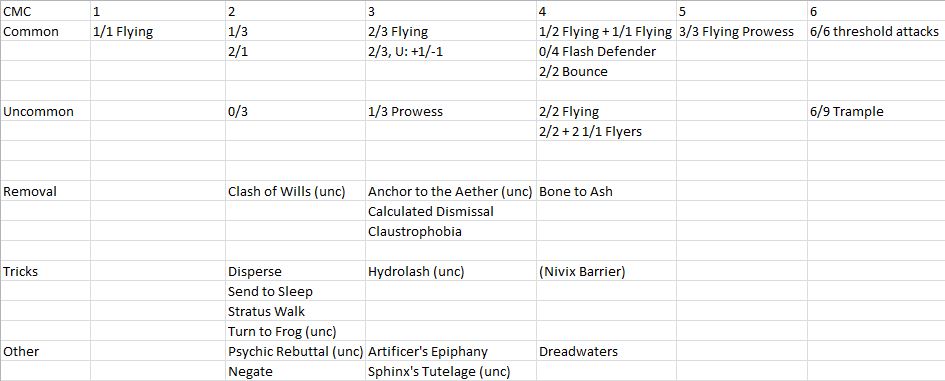 As is often the case, blue looks a little undersized on paper, but will probably punch above its weight. In particular, [mtg_card]Scrapskin Drake[/mtg_card] seems like a stellar flying attacker, and [mtg_card]Watercourser[/mtg_card] seems like a solid blocker. Blue’s two-drops are a bit underwhelming, but [mtg_card]Screeching Skaab[/mtg_card] does the job as a 2/1. [mtg_card]Maritime Guard[/mtg_card] also blocks well, but I have tended to overestimate the impact of truly defensive cards in my limited reviews, so I’m not sure he will make the cut in any but the most truly defensive blue decks.
As is often the case, blue looks a little undersized on paper, but will probably punch above its weight. In particular, [mtg_card]Scrapskin Drake[/mtg_card] seems like a stellar flying attacker, and [mtg_card]Watercourser[/mtg_card] seems like a solid blocker. Blue’s two-drops are a bit underwhelming, but [mtg_card]Screeching Skaab[/mtg_card] does the job as a 2/1. [mtg_card]Maritime Guard[/mtg_card] also blocks well, but I have tended to overestimate the impact of truly defensive cards in my limited reviews, so I’m not sure he will make the cut in any but the most truly defensive blue decks.
Up the curve, [mtg_card]Ringwarden Owl[/mtg_card] looks very good, and I suspect [mtg_card]Aspiring Aeronaut[/mtg_card] will play a little better than it reads—as I mentioned above, I think flying will be very relevant, and other colors in the set (especially white) reward you for spreading the stats over two bodies (see, again, [mtg_card]Ampryn Tactician[/mtg_card], as well as the uncommon [mtg_card]Thunderclap Wyvern[/mtg_card]).
Blue’s uncommons seem especially good. [mtg_card]Sigiled Starfish[/mtg_card] was great in Journey into Nyx, and it looks like it will be an even better blocker here. If the format is indeed a bit slower than Dragons of Tarkir, being able to scry into your best cards will be very valuable. [mtg_card]Jhessian Thief[/mtg_card] looks very tough to block, [mtg_card]Skaab Goliath[/mtg_card] is the biggest common or uncommon creature in the set, and [mtg_card]Whirler Rogue[/mtg_card] might be the best uncommon, period.
For removal, blue gets [mtg_card]Claustrophobia[/mtg_card], which should be excellent—costing one less than [mtg_card]Suppression Bonds[/mtg_card] is good, even if the card is a bit less flexible—and a bunch of countermagic of varying qualities. [mtg_card]Bone to Ash[/mtg_card] is great if you catch something with it, but it will be tough to leave that much mana up, as there aren’t very many creatures with flash in the set. [mtg_card]Turn to Frog[/mtg_card] should be good, but creatures with +1/+1 counters on them keep that bonus, so it won’t always work. [mtg_card]Clash of Wills[/mtg_card] should be good at almost all stages of the game, and [mtg_card]Disperse[/mtg_card] seems like a useful inclusion, as it can reset renowned creatures or save your own creature from [mtg_card]Claustrophobia[/mtg_card] or [mtg_card]Suppression Bonds[/mtg_card].
Black
The black grid:
 Black looks like a slower, more controlling color. Its creatures are relatively undersized, but it makes up for that with plenty of lategame card advantage, and its selection of removal is, as usual, the best of all the colors.
Black looks like a slower, more controlling color. Its creatures are relatively undersized, but it makes up for that with plenty of lategame card advantage, and its selection of removal is, as usual, the best of all the colors.
Black’s creatures look sized to trade with other colors, rather than to attack favorably into an opponent’s defenses. [mtg_card]Deadbridge Shaman[/mtg_card] is a good example. As a 3/1, it kills most everything in the set that costs four mana or less, though it will die itself (not that you’re fussed; your opponent will discard a card, so you come out ahead). [mtg_card]Fetid Imp[/mtg_card] is even better, as giving it deathtouch will just kill everything. There aren’t many creatures with first strike, nor are there many tricks that allow regeneration (though watch out for [mtg_card]Enshrouding Mist[/mtg_card], which prevents damage); your opponent will have to give you something to get past it. [mtg_card]Eyeblight Assassin[/mtg_card] picks off a 2/1 or a Thopter token, then trades with a 2/2. You get the idea.
Of course, since you’re black, all this trading does favor you, in the end. Late in the game you have [mtg_card]Macabre Waltz[/mtg_card] to retrieve two of your best creatures (be sure to hang on to an extra land you can discard). Waltz is especially great for such a plan, because it’s so cheap that you should have mana left over to replay at least one of the creatures you get back. You can also cut out the middleman and put the creature straight into play with [mtg_card]Necromantic Summons[/mtg_card]—provided you have Spell Mastery active, which you should, late in the game, the extra +2/+2 is a substantial bonus.
If you don’t want to trade, [mtg_card]Returned Centaur[/mtg_card], at 2/4, should be a good blocker against almost every small creature in the set; 4 toughness is enough to survive most combats, and 2 power actually deters opponents from attacking you. The Centaur also helps fill your graveyard for later in the game. [mtg_card]Shambling Ghoul[/mtg_card] takes a turn to untap, but after that point it blocks a lot of creatures very effectively.
Black combines this “block and grind” gameplan with good removal and card draw. Reave Soul hits a lot of creatures at five mana and below, albeit at sorcery speed. At five mana, [mtg_card]Unholy Hunger[/mtg_card] is one of the only spells that kills everything, dead, and keeps it off the board. [mtg_card]Cruel Revival[/mtg_card] is similar, but with card advantage attached. [mtg_card]Weight of the Underworld[/mtg_card] is not thrilling, but with [mtg_card]Blightcaster[/mtg_card] and [mtg_card]Auramancer[/mtg_card] also in the set, it can offer value while it kills smaller creatures or disables larger ones.
Red
The red grid:
 Red seems a little confused to me. On the one hand, there are a number of large and difficult-to-block creatures. On the other, there are a number of smaller creatures that seem relatively inconsequential. This leads me to believe red might be better as a support color, rather than a main color, pulling from other colors the tools it needs to maximize what it brings to the deck.
Red seems a little confused to me. On the one hand, there are a number of large and difficult-to-block creatures. On the other, there are a number of smaller creatures that seem relatively inconsequential. This leads me to believe red might be better as a support color, rather than a main color, pulling from other colors the tools it needs to maximize what it brings to the deck.
So first: those tough-to-block guys. [mtg_card]Prickleboar[/mtg_card], while not especially fast to the board, seems very good to me—few creatures in the set effectively block it when it’s attacking, and five damage is a lot. [mtg_card]Boggart Brute[/mtg_card] and [mtg_card]Akroan Sergeant[/mtg_card] seem similar to each other—tough to block, can hit for three. [mtg_card]Cobblebrute[/mtg_card] has no innate evasion, but hits hard and trades with almost everything. [mtg_card]Firefiend Elemental[/mtg_card] will continue to attack well, if you can sneak it in to trigger renowned. [mtg_card]Mage-Ring Bully[/mtg_card] actually seems all right to me, too (though less so for sealed); your opponent has to respect the possibility of a trick, and even becoming 3/3 in the middle of combat can win a fair number of fights.
These cards seem designed to combine with cards like [mtg_card]Stratus Walk[/mtg_card] or [mtg_card]Consecrated by Blood[/mtg_card] in blue or black to make dangerous, high-power attackers that end the game in just a few swings. Against an opponent stumbling on mana, or who just doesn’t have the right answer at the right time (holding [mtg_card]Reave Soul[/mtg_card] instead of [mtg_card]Unholy Hunger[/mtg_card], say), that might be all you need. It’s a little “all-in” for me, but it can be effective—it might not be a bad fail case at the prerelease, where your opponents won’t always have top-shelf removal.
On the other side of things, [mtg_card]Ghirapur Gear-Crafter[/mtg_card] and [mtg_card]Dragon Fodder[/mtg_card] seem tailored for a “go wide” strategy that tries to flood the board with more creatures than the opponent can effectively block. White seems the natural pairing here, as [mtg_card]Ampryn Tactician[/mtg_card], [mtg_card]Consul’s Lieutenant[/mtg_card], and even [mtg_card]Valor in Akros[/mtg_card] can all reward having lots of small creatures. This seems much more effective in draft, where you can craft a deck.
Red’s removal strikes me as a bit underwhelming. [mtg_card]Fiery Impulse[/mtg_card] should be very good at almost all points in the game, especially after Spell Mastery is active, but [mtg_card]Lightning Javelin[/mtg_card] is only 3 damage for four mana, at sorcery speed—it’s most of your turn, and it won’t kill the most threatening things. I like [mtg_card]Fiery Conclusion[/mtg_card] more than most, though, especially in a set where your opponents’ best options for removal may be [mtg_card]Suppression Bonds[/mtg_card] or [mtg_card]Claustrophobia[/mtg_card]. For tricks, [mtg_card]Titan’s Strength[/mtg_card] seems like it doesn’t give enough of a toughness bonus to really boost red’s creatures out of danger, but it may combine effectively with other colors. [mtg_card]Call of the Full Moon[/mtg_card] seems like a good trick, but bear in mind that if you play anything else the turn you cast it, you’ll just sacrifice it during your opponent’s upkeep.
Green
The green grid:
 Green’s creatures don’t get quite as big through the middle of the curve as we’ve seen in recent core sets—Magic 2015 had [mtg_card]Centaur Courser[/mtg_card] and [mtg_card]Invasive Species[/mtg_card], as well as the aforementioned [mtg_card]Siege Wurm[/mtg_card]—but it has the power where it counts.
Green’s creatures don’t get quite as big through the middle of the curve as we’ve seen in recent core sets—Magic 2015 had [mtg_card]Centaur Courser[/mtg_card] and [mtg_card]Invasive Species[/mtg_card], as well as the aforementioned [mtg_card]Siege Wurm[/mtg_card]—but it has the power where it counts.
Specifically, it has the power in [mtg_card]Rhox Maulers[/mtg_card], which outclasses every other common at its mana cost, fights well against similarly-costed uncommons, and grows to be as big as practically everything else in the set. Seriously, go back and check the five- and six-mana spells in those charts—renowned Maulers beat or trade with everything except Skaab Goliath. Ramping this out early with [mtg_card]Leaf Gilder[/mtg_card] is a legitimate game plan all in its own. (I’m less enamored of [mtg_card]Nissa’s Pilgrimage[/mtg_card], but that card also serves a role in the right deck.)
Down the curve, green’s creatures feel a bit more tempo-oriented than we’re used to seeing. Several creatures replace themselves when they enter the battlefield, like [mtg_card]Elvish Mystic[/mtg_card], [mtg_card]Llanowar Empath[/mtg_card], and, at uncommon, [mtg_card]Sylvan Messenger[/mtg_card]. These seem mostly designed for the black-green Elf deck, which strikes me as mostly a draft thing, but in sealed formats (like the prerelease) they provide reasonable bodies and keep you moving through your deck. [mtg_card]Orchard Spirit[/mtg_card] is a good evasive card. [mtg_card]Yeva’s Forcemage[/mtg_card] can never get flash, so it’s not a great trick, but the extra power can force through a renown creature to connect for the +1/+1 counter.
[mtg_card]Timberpack Wolf[/mtg_card] is never going to be bad. The worst case is a 2/2 for two mana, and we’ve already established with [mtg_card]Cleric of the Forward Order[/mtg_card] such a creature is fine. Given how good 3/3s and 4/4s look to be in this format, two or three Timberwolves together create a solid board presence. They play to the tempo aspect of green, too, as each additional wolf adds power to the ones you have already, throwing off your opponent’s combat math. Remember: the lone wolf dies, but the pack survives.
Green’s uncommons look very good as well. [mtg_card]Skysnare Spider[/mtg_card] is like renown [mtg_card]Rhox Maulers[/mtg_card], but with vigilance and reach. [mtg_card]Somberwald Alpha[/mtg_card] looks like it makes blocking very difficult for your opponent. [mtg_card]Joraga Invocation[/mtg_card] plays the role of [mtg_card]Overrun[/mtg_card]—no trample, but you should kill every blocker your opponent has, so you can take it from there, right?
As usual, Green doesn’t have the greatest removal, but [mtg_card]Wild Instincts[/mtg_card] will do in a pinch. This card is pretty similar to [mtg_card]Epic Confrontation[/mtg_card], which turned out to be possibly the best common in Dragons of Tarkir. Four mana is a lot to pay, though. [mtg_card]Epic Confrontation[/mtg_card] was cheap enough that you could use it to kill a creature, get a (better) attack in, and still have mana left over to summon something else. [mtg_card]Wild Instincts[/mtg_card] will usually take your whole turn. Green makes up for this with [mtg_card]Titanic Growth[/mtg_card], which—if we’re right that 4/4 is the critical creature size—should make your creature outclass everything else in play. [mtg_card]Might of the Masses[/mtg_card] should do similar work in most games. And [mtg_card]Aerial Volley[/mtg_card] is most likely a sideboard card, but it’s a very good one when your opponent has targets for it.
Gold Cards and Artifacts
There’s not as much to say here—all of the gold uncommons look great, and they should be major draws to their respective color combinations.
As for artifacts, [mtg_card]Guardian Automaton[/mtg_card] is a solid option for any deck as a 3/3 for four mana. Similarly, [mtg_card]Gold-Forged Sentinel[/mtg_card] also seems like a realistic option. I’m not a fan of [mtg_card]Bonded Construct[/mtg_card]—it seems too likely it will trade unfavorably by the time it actually gets to attack. Veteran’s Sidearm could be pretty good, though; if moving from 2/2 to 3/3, or 2/3 to 3/4, is actually a substantial jump, it seems like a valuable piece of equipment. In a pinch, it upgrades your Thopters from trivialities into real threats.
The Mechanics
Magic Origins introduces two new mechanics—renown and spell mastery. We’ve already talked a lot about renown. To sum up, I think it will encourage attacking early. Creatures that trigger their renown bonuses will be big enough to keep on mattering into the later turns. It should make combat tricks a little better, since your opponents will want to block. It also makes bounce spells a little better, as they reset opposing renowned creatures.
If renown pushes players toward aggression, spell mastery will push them toward control. In most cases, however, limited decks will only have between seven and nine spells total—few enough that I think most cards with spell mastery have to be evaluated as though you won’t get the bonus. At the same time, the spell mastery kicker on something like [mtg_card]Unholy Hunger[/mtg_card] is especially attractive for a controlling deck, which needs the life to stabilize later in the game. Fortunately, for most of these spells, the mastery kicker falls closer to “nice bonus” than “crucial for success.”
Spell mastery does make cards that replace themselves, like [mtg_card]Healing Hands[/mtg_card] and [mtg_card]Dark Dabbling[/mtg_card], a bit better than they would normally be, since putting the spell in your graveyard after it resolves is something you’re suddenly very interested in doing. That’s not a free pass to play bad cards, but it is something to keep in mind if your deck seems like it’s going to play for the long game.
Final Thoughts and Lingering Questions
So! That was a lot of words.
Here’s the TL;DR version, if you just scrolled straight to the bottom for my summary (clever, you):
- Magic Origins will be faster and more cohesive than core sets we’re used to. This is much more like an expert expansion than a core set.
- Origins should be a bit slower than Dragons of Tarkir, which was a medium-speed format that rewarded aggression. Attacking should be good, and the creatures are attractive, but removal is a bit worse and the board could get cluttered.
- Flying should matter. There should be a fair number of incidental Thopters skimming through the skies, and white in particular has a number of efficient flyers. Even green gets in on the fun.
- 4/4 is the critical frame. 4 toughness, in general, should block most things. 2 power kills a lot of things. 3/3 is in the middle, killing a lot of the smaller stuff while occasionally trading down. 4/4s should win most fights; 6/6s (hi, [mtg_card]Rhox Maulers[/mtg_card]) should be enormous.
- Renown should push a little toward aggression, spell mastery a bit toward control. Renown should make combat tricks a bit better, and possibly bounce as well.
And here are my lingering questions:
- Without playing, it’s not completely clear to me how much the jump from 2/2 to 3/3 will matter. It looks important on paper, but there are enough 3/2 and 3/1 creatures that I could be wrong. 2/3 to 3/4 seems like a very significant jump, though (for your [mtg_card]Pharika’s Disciple[/mtg_card]s).
- Over in his set review, Ari Lax observes that many colors don’t have good ways to catch up from behind. This is something we noted above in white, for example, which doesn’t have a lot of high-toughness blockers to stablize. I suspect it won’t matter so much for sealed, but it’s possible this will be a more aggressive draft format if he is right.
For the prerelease, black seems especially good in the slower sealed format. White and green seem like they have very good uncommons. Red and blue seem a little more synergy-driven, and they may be the support colors for this set. (In fairness, In the end, don’t let me dissuade you from picking what you want, since having fun is the most important part of the prerelease!
If you want yet more reading material, Luis Scott-Vargas rates each card in his limited set reviews at ChannelFireball.com, and Ari Lax has a stellar series for Star City Games (behind a paywall), whose methodology I have cribbed from here.
What are you hoping to open or draft at the prerelease? What cards seem the best to you? Sound off in the comments or hit me up on Twitter to let me know what you think.

